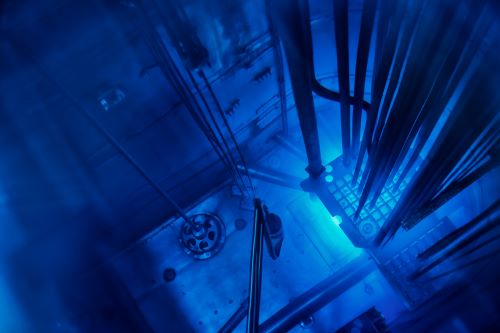Autumn 2024 saw the start of a nuclear movement in the U.S.
After decades (and decades) of shrugging off the pathetic pace of the nation’s nuclear power development, major corporations and the federal government put reactors in a warm embrace.
Still, the chances of nuclear making any kind of major contribution to the country’s power needs over the next 15 years are slim, and some of these moves could be distractions for an oncoming battle for electricity.
Just about every behemoth tech company made announcements to bring nuclear online. Microsoft announced plans to restart part of the closed Three Mile Island Nuclear Generation Station on Sept. 20.
Google and Amazon then raced to make their announcements. On Oct. 14, Google published a deal with Kairos Power to develop small modular reactors (SMR). Two days later, Amazon announced a deal to develop the same technology with two companies, X-energy and Dominion Energy, leading two different projects.
The government also stepped in with the U.S. Department of Energy putting up $900 million in funding to help the deployment of the first commercial SMRs within the country.
The announcements are made in a time of a growing awareness of a growing problem. The U.S. does not have anywhere near the amount of power needed for an artificial intelligence (AI) boom, an increase in electric vehicles and a growing reshoring movement as more companies move their manufacturing operations back to the U.S.
An acceptance of nuclear power is great news. It will also not solve the problem, at least not anytime soon.
Critical reactions

Full disclosure: I spent the first part of the 2020s trying to enter the nuclear industry. I’m still a fan of nuclear power. It has too much potential to ignore.
One 20-gram pellet of nuclear fuel produces as much energy as a ton of coal, 149 gallons of oil or 17,000 cf of natural gas. It produces no greenhouse gases. Once up and running, the plants require comparatively little in the way of maintenance or fuel.
I was lucky enough to land a job as an on-site administrative assistant for Bechtel when the contractor finished building Plant Vogtle, the first U.S. nuclear power plant in 30 years. The engineering and scale of the project amazed me. The 15-story reactor domes that are built to withstand a commercial airliner crashing into it. The 50-story concrete cooling towers and massive pipes needed to channel the water necessary to keep the nuclear reaction going.
The last reactor went online in spring 2024 and added about 2.4 gigawatts (GW) of electricity to the Southeast’s power grid.
Neat—but it’s also impossible to ignore the difficulties.
It had been more than 30 years since anyone in the U.S. had attempted to build a nuclear power plant. Southern Co. had to run a gauntlet of complications.
Construction started in 2009. Georgia Southern and contractors were suing each other over delays by 2015. The contractors and the Nuclear Regulatory Commission got sideways over new regulations, causing major rebuilds.
In 2017, the project bankrupted Westinghouse, the plant designer. One of Southern Co.’s partners, South Carolina Electric and Gas, decided the project was too expensive and dropped out. Two of the South Carolina power company’s executives received prison sentences.
Bechtel, one of the few firms with nuclear experience, was eventually called in to figure out how to complete the project. And all that happened before COVID hit.
Vogtle missed its in-service date by seven years. The final cost surpassed $31 billion, well over twice the original estimate. Thanks to the construction costs and some other factors, Georgia residents, in some cases, have seen their electric bills rise by 50% over the last year, according to news reports.
Power limits
Hopefully, the nuclear industry and government regulators learned lessons from Vogtle, and the next go-round won’t be as difficult.
It will most likely still be difficult. The nuclear power projects announced by the U.S. tech industry’s leaders look promising, but they also look like they are way behind the demand curve.
Microsoft’s plan to restart the Three Mile Island facility looks the easiest. The facility is already built, the engineering is already done. (Reactor 2, which experienced the partial meltdown in 1979, will not be restarted.)
Even then, the cost is outrageous. East Daley Analyst Nigel Gorbold told the audience at Hart Energy’s A&D Strategies and Opportunities Conference in October that the project’s estimated megawatt-hour (MWh) cost is around $130. Natural gas-fired power comes in at around $15-$25/MWh.
Besides the cost, adding Three Mile Island, or restarting some of the U.S.’ other shuttered nuclear plants, will not come close to meeting the country’s growing electrical demand, said EQT CEO Toby Rice during his company’s third-quarter earnings call.
The company looked at the potential of shuttered nuclear facilities coming back online and found they added a potential 3 GW to the grid.
“Keep in mind, some of the power demand growth estimates are around 70 to 80 gigawatts,” Rice said. “Relative to what’s required, it’s a drop in the bucket. It’s not meaningful. And it still needs to happen, but the world is going to be looking for fresh, reliable, affordable energy sources. That’s going to mean more natural gas.”
Amazon’s and Google’s pledge to develop SMRs is a positive development. The technology is a viable option that should have been pursued decades ago.
The problem currently is that the technology is a long way off from commercial use. Google hopes to have its first SMR online by 2030, with additional deployments through 2035 that will add 500 megawatts of power. Amazon says it’s aiming for deployment in the early 2030s.
All of it sounds good, but nuclear projects are notorious for falling behind schedule and going over budget, and SMRs are a developing technology. There are more than 80 SMR designs and concepts globally, according the International Atomic Energy Agency. There are three SMRs in commercial operation, none in the U.S.
The projects face a difficult regulatory process before making a dent in meeting the overall demand.
Though, as Rice said, they need to be done. According to most power regulators, the U.S. is heading toward a period when electrical demand is going to shoot well past supply.
A lot of techno-geeks have talked about the transformational nature of the coming AI revolution.
Maybe. And maybe in a few years, when everyone is creating hi-res images of their dogs and cats fighting with light sabers, they’ll wonder why their electric bills have gone nuclear.
Recommended Reading
Crescent Energy Closes $905MM Acquisition in Central Eagle Ford
2025-01-31 - Crescent Energy’s cash-and-stock acquisition of Carnelian Energy Capital Management-backed Ridgemar Energy includes potential contingency payments of up to $170 million through 2027.
Constellation Bets Big on NatGas in $16.4B Deal for Calpine
2025-01-10 - Constellation Energy will acquire Calpine Corp. in a $26.6 billion deal, including debt, that will give the pure-play nuclear company the largest natural gas power generation fleet.
Report: Will Civitas Sell D-J Basin, Buy Permian’s Double Eagle?
2025-01-15 - Civitas Resources could potentially sell its legacy Colorado position and buy more assets in the Permian Basin— possibly Double Eagle’s much-coveted position, according to analysts and media reports.
Petro-Victory Buys Oil Fields in Brazil’s Potiguar Basin
2025-02-10 - Petro-Victory Energy is growing its footprint in Brazil’s onshore Potiguar Basin with 13 new blocks, the company said Feb. 10.
Apollo Funds Acquires NatGas Treatment Provider Bold Production Services
2025-02-12 - Funds managed by Apollo Global Management Inc. have acquired a majority interest in Bold Production Services LLC, a provider of natural gas treatment solutions.
Comments
Add new comment
This conversation is moderated according to Hart Energy community rules. Please read the rules before joining the discussion. If you’re experiencing any technical problems, please contact our customer care team.






